History of slavery in New York (state)
The systematic enslavement of African people in the United States began in New York as part of the Dutch slave trade. The Dutch West India Company imported eleven African slaves to New Amsterdam in 1626, with the first slave auction held in New Amsterdam in 1655.[1] With the second-highest proportion of any city in the colonies (after Charleston, South Carolina), more than 42% of New York City households held slaves by 1703, often as domestic servants and laborers.[2] Others worked as artisans or in shipping and various trades in the city. Slaves were also used in farming on Long Island and in the Hudson Valley, as well as the Mohawk Valley region.
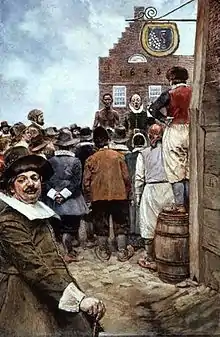
During the American Revolutionary War, the British troops occupied New York City in 1776. The Crown promised freedom to slaves who left rebel masters, and thousands moved to the city for refuge with the British. By 1780, 10,000 black people lived in New York. Many were slaves who had escaped from their slaveholders in both northern and southern colonies. After the war, the British evacuated about 3,000 slaves from New York, taking most of them to resettle as free people in Nova Scotia, where they are known as Black Loyalists.
Of the northern states, New York was next to last in abolishing slavery. (In New Jersey, mandatory, unpaid "apprenticeships" did not end until the Thirteenth Amendment ended slavery, in 1865.)[3]:44
After the American Revolution, the New York Manumission Society was founded in 1785 to work for the abolition of slavery and to aid free blacks. The state passed a 1799 law for gradual abolition, a law which freed no living slave. After that date, children born to slave mothers were required to work for the mother's master as indentured servants until age 28 (men) and 25 (women). The last slaves were freed on July 4, 1827 (28 years after 1799).[1] African Americans celebrated with a parade.
Dutch rule
| Part of a series on |
| Slavery |
|---|
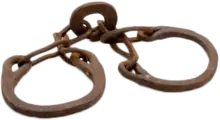 |
Initial group of slaves
In 1613, Juan (Jan) Rodriguez from Santo Domingo became the first non-indigenous person to settle in what was then known as New Amsterdam.[4]
Systematic slavery began in 1626 in the present-day state of New York, when eleven captive Africans arrived on a Dutch West India Company ship in the New Amsterdam harbor.[5][4] Historian Ira Berlin called them Atlantic Creoles who had European and African ancestry and spoke many languages. In some cases, they attained their European heritage in Africa when European traders conceived children with African women. Some were Africans who were crew members on ships and some came from ports of the Americas.[6][lower-alpha 1] Their first names—like Paul, Simon, and John—indicated if they had European heritage. Their last names indicated where they came from, like Portuguese, d'Congo, or d'Angola. People from the Congo or Angola were known for their mechanical skills and docile manners. Six slaves had names that indicated a connection with New Amsterdam, such as Manuel Gerritsen, which he likely received after their arrival in New Amsterdam and to differentiate from repeated first names.[6] Men were laborers who worked the fields, built forts and roads, and performed other forms of labor.[5] According to the principle of partus sequitur ventrem adopted from southern colonies, children born to enslaved women were considered born into slavery, regardless of the ethnicity or status of the father.[1]

In February 1644, the eleven slaves petitioned Willem Kieft, the director general for the colony, for their freedom. This occurred during a time where there were skirmishes with Native American people and the Dutch wanted blacks to help protect their settlements and did not want the slaves to join the Native Americans. These eleven slaves were granted partial freedom, where they could buy land and a home and earn a wage from their master, and then full freedom. Their children remained in slavery. By 1664, the original eleven slaves, as well as other slaves who had attained half-freedom, for a total of at least 30 black landowners, lived on Manhattan near the Fresh Water Pond.[7][4]
Slave trade
For more than two decades after the first shipment, the Dutch West India Company was dominant in the importation of slaves from the coasts of Africa. A number of slaves were imported directly from the company's stations in Angola to New Netherland.[5]
Due to a lack of workers in the colony, it relied upon on African slaves, who were described by the Dutch as "proud and treacherous", a stereotype for African-born slaves.[5] The Dutch West India Company allowed New Netherlanders to trade slaves from Angola for "seasoned" African slaves from the Dutch West Indies, particularly Curaçao, who sold for more than other slaves. They also bought slaves that came from privateers of Spanish slave ships.[5] For instance, La Garce a French privateer, arrived in New Amsterdam in 1642 with Spanish Negroes that were captured from a Spanish ship. Although they claimed to be free, and not African, the Dutch sold them as slaves due to their skin color.[6]
Slaves in the north were often owned by notable people like Benjamin Franklin, William Penn and John Hancock. In New Amsterdam, William Henry Seward grew up in a slave-owning family. Against slavery, he became Abraham Lincoln's Secretary of State during the Civil War.[8]
Unique to slaves from other colonies, slaves could sue another person whether white or black. Early instances included suits filed for lost wages and damages when a slave's dog was injured by a white man's dog. Slaves could also be sued.[lower-alpha 2]
Partial and full freedom
By 1644, some slaves had earned partial freedom, or half-freedom, in New Amsterdam and were able to earn wages. They had other rights in the commercial economy, and intermarriage with working-class whites was frequent.[10] Land grant records show that Land of the Blacks was located just north of New Amsterdam. As the English began to seize New Amsterdam in 1664, the Dutch freed about 40 men and women who had been granted half-slave status, to ensure that the English would not keep them enslaved. The new freemen had their original land grants finalized and all grants were officially marked as being owned by the new freemen.[11]
English rule

In 1664, the English took over New Amsterdam and the colony. They continued to import slaves to support the work needed. Enslaved Africans performed a wide variety of skilled and unskilled jobs, mostly in the burgeoning port city and surrounding agricultural areas. In 1703, more than 42% of New York City's households held slaves, a percentage higher than in the cities of Boston and Philadelphia, and second only to Charleston in the South.[2]
In 1708, the New York Colonial Assembly passed a law entitled "Act for Preventing the Conspiracy of Slaves" which prescribed a death sentence for any slave who murdered or attempted to murder his or her master. This law, one of the first of its kind in Colonial America, was in part a reaction to the murder of William Hallet III and his family in Newtown (Queens).[12]
In 1711, a formal slave market was established at the end of Wall Street on the East River, and it operated until 1762.[13]
An act of the New York General Assembly, passed in 1730, provided that:
Forasmuch as the number of slaves in the cities of New York and Albany, as also within the several counties, towns and manors within this colony, doth daily increase, and that they have oftentimes been guilty of confederating together in running away, and of other ill and dangerous practices, be it therefore unlawful for above three slaves to meet together at any time, nor at any other place, than when it shall happen they meet in some servile employment for their masters' or mistresses' profit, and by their masters' or mistresses' consent, upon penalty of being whipped upon the naked back, at the discretion of any one justice of the peace, not exceeding forty lashes for each offense.[14]
Manors and towns could appoint a common whipper at no more than three shillings per person.[15] Blacks were given the lowest status jobs, the ones the Dutch did not want to perform, like meting out corporal punishment and executions.[16]
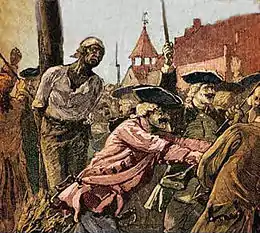
As in other slaveholding societies, the city was swept by periodic fears of slave revolt. Incidents were misinterpreted under such conditions. In what was called the New York Conspiracy of 1741, city officials believed a revolt had started. Over weeks, they arrested more than 150 slaves and 20 white men, trying and executing several, in the belief they had planned a revolt. Historian Jill Lepore believes whites unjustly accused and executed many blacks in this event.[17]
In 1753, the Assembly provided there should be paid "for every negro, mulatto or other slave, of four years old and upwards, imported directly from Africa, five ounces of Sevil[le] Pillar or Mexico plate [silver], or forty shillings in bills of credit made current in this colony."[18]
American Revolution
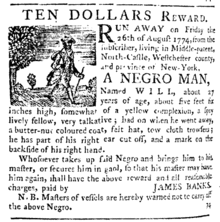
African Americans fought on both sides in the American Revolution. Many slaves chose to fight for the British, as they were promised freedom by General Guy Carleton in exchange for their service. After the British occupied New York City in 1776, slaves escaped to their lines for freedom. The black population in New York grew to 10,000 by 1780, and the city became a center of free blacks in North America.[10] The fugitives included Deborah Squash and her husband Harvey, slaves of George Washington, who escaped from his plantation in Virginia and reached freedom in New York.[10]
In 1781, the state of New York offered slaveholders a financial incentive to assign their slaves to the military, with the promise of freedom at war's end for the slaves. In 1783, black men made up one-quarter of the rebel militia in White Plains, who were to march to Yorktown, Virginia for the last engagements.[10]
By the Treaty of Paris (1783), the United States required that all American property, including slaves, be left in place, but General Guy Carleton followed through on his commitment to the freedmen. When the British evacuated from New York, they transported 3,000 Black Loyalists on ships to Nova Scotia (now Maritime Canada), as recorded in the Book of Negroes at the National Archives of Great Britain and the Black Loyalists Directory at the National Archives at Washington.[10][19] With British support, in 1792 a large group of these Black Britons left Nova Scotia to create an independent colony in Sierra Leone.[20]
Gradual abolition
In 1781, the state legislature voted to free those slaves who had fought for three years with the rebels or were regularly discharged during the Revolution.[21] The New York Manumission Society was founded in 1785, and worked to prohibit the international slave trade and to achieve abolition. It established the African Free School in New York City, the first formal educational institution for blacks in North America. It served both free and slave children. The school expanded to seven locations and produced some of its students advanced to higher education and careers. These included James McCune Smith, who gained his medical degree with honors at the University of Glasgow after being denied admittance to two New York colleges. He returned to practice in New York and also published numerous articles in medical and other journals.[10]
By 1790, one in three blacks in New York state were free. Especially in areas of concentrated population, such as New York City, they organized as an independent community, with their own churches, benevolent and civic organizations, and businesses that catered to their interests.[10]
Although there was movement towards abolition of slavery, the legislature took steps to characterize indentured servitude for blacks in a way that redefined slavery in the state. Slavery was important economically, both in New York City and in agricultural areas, such as Brooklyn. In 1799, the legislature passed the Act for the Gradual Abolition of Slavery. It freed no living slave. It declared children of slaves born after July 4, 1799, to be legally free, but the children had to serve an extended period of indentured servitude: to the age of 28 for males and to 25 for females. Slaves born before that date were redefined as indentured servants and could not be sold, but they had to continue their unpaid labor.[22] From 1800 to 1827, white and black abolitionists worked to end slavery and attain full citizenship in New York. During this time, there was a rise in white supremacy, which was at odds with the increased anti-slavery efforts of the early 19th century.[23] Peter Williams Jr., an influential black abolitionist and minister, encouraged other blacks to "by a strict obedience and respect to the laws of the land, form an invulnerable bulwark against the shafts of malice" to better the chances of freedom and a better life.[24]
African-Americans' participation as soldiers in defending the state during the War of 1812 added to public support for their full rights to freedom. In 1817, the state freed all slaves born before July 4, 1799 (the date of the gradual abolition law), to be effective in 1827. It continued with the indenture of children born to slave mothers until their 20s, as noted above.[22] Because of the gradual abolition laws, there were children still bound in apprenticeships when their parents were free.[25] This encouraged African-American anti-slavery activists.[25]
In Sketches of America (1818) British author Henry Bradshaw Fearon, who visited the young United States on a fact-finding mission to inform Britons considering emigration, described the situation in New York City as he found it in August 1817:

New York is called a "free state:" that it may be so so theoretically, or when compared with its southern neighbors; but if, in England, we saw in the Times newspaper such advertisements as the following (see image to right), we should conclude that freedom from slavery existed only in words.[26]
On July 5, 1827, the African-American community celebrated final emancipation in the state with a parade through New York City.[24][27] July 5 was chosen over July 4, because the national holiday was not meant for blacks, as Frederick Douglass stated in his famous What to the Slave Is the Fourth of July? speech of July 5, 1852.[27]
Right to vote
New York residents were less willing to give blacks equal voting rights. By the constitution of 1777, voting was restricted to free men who could satisfy certain property requirements for value of real estate. This property requirement disfranchised poor men among both blacks and whites. The reformed Constitution of 1821 eliminated the property requirement for white men, but set a prohibitive requirement of $250 (equivalent to $5,000 in 2019), about the price of a modest house,[28] for black men.[22] In the 1826 election, only 16 blacks voted in New York City.[3]:47 "As late as 1869, a majority of the state's voters cast ballots in favor of retaining property qualifications that kept New York's polls closed to many blacks. African-American men did not obtain equal voting rights in New York until ratification of the Fifteenth Amendment to the United States Constitution, in 1870."[22]
Freedom's Journal
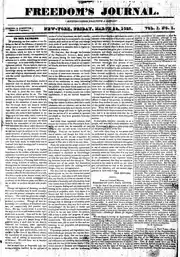
Beginning March 16, 1827, John Brown Russwurm published Freedom's Journal, written by and directed to African Americans.[29][30] Samuel Cornish and John Russwurm were editors of the journal; they used it to appeal to African Americans across the nation.[31] The powerful words published spread rapid positive influence to African Americans who could help establish a new community. The emergence of an African-American journal was a very important movement in New York. It showed that blacks could gain education and be part of literate society.[32]
White newspapers published a fictional "Bobalition" print series. This was made in mockery of blacks, using the way an uneducated colored person would pronounce abolition.[33]
Involvement in the illegal slave trade
Beginning in the early 1850s, New York City became a key center for the Atlantic slave trade, which Congress had banned in 1807. The main slave traders arrived in Manhattan during this period from Brazil and Africa, and became known as the Portuguese Company. Two of the key traffickers were Manoel Basilio da Cunha Reis and Jose Maia Ferreira. They posed as merchants in legal trade but in fact bought up vessels which they sent to the African coast, usually the Congo River region. The vast majority of vessels were ultimately bound for Cuba. In total over 400 illegal slave vessels left the United States during this period, the vast majority from New York, although others departed from New Orleans, Boston, and other minor ports. This trade was enabled by American captains and sailors, corrupt U.S. officials in New York, and by the ruling Democratic Party, which had limited interest in suppressing the trade.
African Burial Ground
In 1991, a construction project required an archaeological and cultural study of 290 Broadway in Lower Manhattan to comply with the National Historic Preservation Act of 1966 before construction could begin. During the excavation and study, human remains were found in a former six-acre burial ground for African Americans that dated from the mid-1630s to 1795. It is believed that there are more than 15,000 skeletal remains of colonial New York's free and enslaved blacks. It is the country's largest and earliest burial ground for African-Americans.[34]
This discovery demonstrated the large-scale importance of slavery and African Americans to New York and national history and economy. The African Burial Ground has been designated as a National Historic Landmark and a National Monument for its significance. A memorial and interpretive center for the African Burial Ground have been created to honor those buried and to explore the many contributions of African Americans and their descendants to New York and the nation.[35]
See also
Notes
- The Dutch engaged in battles with the Spanish and French as they sought to have a hold on the slave trade and they would keep people of color as war prizes, with no distinction between those who may have been slaves, and those who were free crew members.[6]
- On December 9, 1638, a slave known as Anthony the Portuguese sued a white merchant, Anthony Jansen from Salee, and was awarded reparations for damages caused to his hog by the defendant's dog. In the following year Pedro Negretto successfully sued an Englishman, John Seales, for wages due for tending hogs. Manuel de Reus, a servant of the Director General Willem Kieft, granted a power of attorney to the commas at Fort Orange to collect fifteen guilders in back wages for him from Hendrick Fredricksz." Unique to this colony was how punishment could be given to a Slave. In this case he was suited, "...in 1639 a white merchant Jan Jansen Damen, sued Little Manuel (sometimes called Manuel Minuit) and was in turn sued by Manuel de Reus; both cases were settled out of court."[9]
References
- Harper, Douglas (2003). "Emancipation in New York". Slavery in the North.
- Oltman, Adele (November 7, 2005). "The Hidden History of Slavery in New York". The Nation.
- Foner, Eric (2015). Gateway to Freedom. The Hidden History of the Underground Railroad. New York: W.W. Norton. ISBN 9780393244076.
- Hodges, Graham R.G (2005). "Root and Branch: African Americans in New York and East New Jersey, 1613-1863". U. of North Carolina Press. Retrieved February 4, 2021.
- Harper, Douglas (2003). "Slavery in New York". Slavery in the North. Retrieved September 27, 2011.
- Harris, Leslie M. (2004-08-01). In the Shadow of Slavery: African Americans in New York City, 1626-1863. University of Chicago Press. pp. 18–19. ISBN 978-0-226-31775-5.
- Harris, Leslie M. (2004-08-01). In the Shadow of Slavery: African Americans in New York City, 1626-1863. University of Chicago Press. pp. 23–24. ISBN 978-0-226-31775-5.
- Harper, Douglas (2003). "Slavery in the North". Slavery in the North. Retrieved March 16, 2020.
- Faucquez, Anne-Claire (2019). ""Corporate Slavery in Seventeenth-Century New York" in Catherine Armstrong, The Many Faces of Slavery. New Perspectives on Slave Ownership and Experiences in the Americas". Bloomsbury. ISBN 9781350071445. Retrieved January 29, 2021.
- "Exhibit: Slavery in New York". New York Historical Society. October 2005. Retrieved February 11, 2008.
- Peter R. Christoph, "Freedmen of New Amsterdam", Selected Rensselaerwicjk Papers, New York State Library, 1991
- Wolfe, Missy. Insubordinate Spirit: A True Story of Life and Loss in Earliest America 1610-1665. Guilford CT, 2012, pp. 192–194.
- Philip, Abby. "A permanent reminder of Wall Street’s hidden slave-trading past is coming soon", Washington Post, April 15, 2015, retrieved February 10, 2017.
- Dillon, John Brown (1879). Oddities of Colonial Legislation in America: As Applied to the Public Lands, Primitive Education, Religion, Morals, Indians, Etc., with Authentic Records of the Origin and Growth of Pioneer Settlements, Embracing Also a Condensed History of the States and Territories. R. Douglass. pp. 225–226.
- Weise, Arthur James (1880). History of the seventeen towns of Rensselaer County, from the colonization of the Manor of Rensselaerwyck to the present time. Troy, New York. p. 6.
- Harris, Leslie M. (2004-08-01). In the Shadow of Slavery: African Americans in New York City, 1626-1863. University of Chicago Press. p. 20. ISBN 978-0-226-31775-5.
- Lepore, Jill, New York Burning; Liberty, Slavery, and Conspiracy in Eighteenth-Century Manhattan, 2005.
- Excise, New York (State) Department of (1897). Annual Report of the State Commissioner of Excise of the State of New York. Department of Excise. p. 523.
- "African Nova Scotians". March 2020. Retrieved March 17, 2020.
- The Journal of Negro History. United Pub. Corporation. 1922. p. 184.
- Eisenstadt, Peter (2005-05-19). Encyclopedia of New York State. Syracuse University Press. p. 19. ISBN 978-0-8156-0808-0.
- "African American Voting Rights" Archived November 9, 2010, at the Library of Congress Web Archives, New York State Archives, retrieved February 11, 2012
- Gellman, David N. (August 2008). Emancipating New York: The Politics of Slavery and Freedom, 1777–1827. LSU Press. p. 10. ISBN 978-0-8071-3465-8.
- Peterson, Carla L. (2011-02-22). Black Gotham: A Family History of African Americans in Nineteenth-Century New York City. Yale University Press. p. 1826. ISBN 978-0-300-16409-1.
- Harris, Leslie M. In the Shadow of Slavery: African Americans in New York City, 1626–1863. Chicago: University of Chicago Press, 2003: 93–95.
- Fearon, Henry Bradshaw (1818). Sketches of America: A Narrative Journey of Five Thousand Miles Through the Eastern and Western States. London: Longman, Hurst, Rees, Orme, and Brown. pp. 56–57.
- Sinha, Manisha (2016-02-23). The Slave's Cause: A History of Abolition. Yale University Press. p. 201. ISBN 978-0-300-18208-8.
- Harper, Douglas (2003). "Emancipation in New York".
- Hodges, Graham Russell (2010). David Ruggles: A Radical Black Abolitionist and the Underground Railroad in New York City. Univ of North Carolina Press. p. 33. ISBN 978-0-8078-3326-1.
- Penn, Irvine Garland (1891). The Afro-American Press and Its Editors. Willey & Company. pp. 26.
- Capie, Julia M. "Freedom of Unspoken Speech: Implied Defamation and Its Constitutional Limitations". Touro Law Review 31, no. 4 (October 2015): 675.
- Gellman, David N. "Race, the Public Sphere, and Abolition in Late Eighteenth-Century New York," Journal of the Early Republic 20, no. 4 (2000): 607–36.
- "Bobalition of slavery". Library of Congress, Washington, D.C. 20540 USA. Retrieved 2020-11-16.
- "History & Culture - African Burial Ground National Monument (U.S. National Park Service)". National Park Service. Retrieved March 17, 2020.
- "African Burial Ground National Monument", National Park Service; retrieved December 29, 2007
Further reading
- Bruno, Debra (July 22, 2020). "History Lessons". Washington Post.
- Oltman, Adele (November 5, 2007). "The Hidden History of Slavery in New York". The Nation.
- Harris, John (2020). The Last Slave Ships: New York and the End of the Middle Passage. ISBN 978-0300247336.
External links
- Slavery in New York, October 2005 – September 2007, an exhibition by the New-York Historical Society
- "Interview: James Oliver Horton: Exhibit Reveals History of Slavery in New York City", PBS Newshour, January 25, 2007
- Slavery In Mamaroneck Township, Larchmont Website